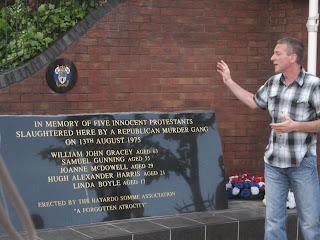
Hello again! I hope you are all excited to read more about my travels!
Nina an I again traveled the two hour journey to Belfast to spend our second and third days working at Belfast Exposed. The dynamic of the workplace is completely different than anything I have seen in the United States. The first day we were there both Nina and I thought the lack of structure and plans were just an component of getting used to and integrated into a new space. However, I have come to see that people here simply don’t have such structured and planed out days, both at work and in everyday life. I am so used to the hustle and bustle of every activity at home that it is almost hard to accept that other cultures are more relaxed and carefree about their time schedules.
A result of this lack of planing lead us to spend a good portion of our second day talking with Melvin, the resident photographer and community workshop leader. He has taken many of the pictures that make up the archive and is able to talk in detail about almost every photo. We talked for a long time about his current project, which he has been working on for years. Every summer for almost 100 years the Protestant communities in several cities and towns in Northern Ireland build huge bonfires out
I asked him if I would be able to attend the bonfire celebration (if I were here on that night) and he assured me that they are very safe until a certain point in the night when “you just know when to leave” before the drunken rowdiness and fighting begins. I was interested in hear that tourists would be welcome to this huge celebration of Protestant and Unionist identity. I thought this would be a time when outsiders would not be accepted. I then asked if Marvin had ever attended a bonfire when he was growing up. He replied that he would not have been allowed to, a quite obvious sign of his Catholic, Republican upbringing.
After living in Northern Ireland for over a week now and knowing

a “wee bit” more about the conflict I find myself trying to figure out which side people are on. Some people, mostly the professors who give our lectures, seem more neutral and it is hard to pin point their history. Often they will make a fleeting comment which then shows their orientation. I find these moments very interesting because they try to give unbiased information, but there always seems to be a moment when their personal biases and orientations become evident. On the other hand, others do not wish to hid their backgrounds. For example, a member of the Ulster Volunteer Force led our group through a tour of Unionist Murals in Belfast yesterday. He was wearing a short sleeved shirt
 revealing a tattoo on his forearm saying U.V.F. POW 76.He wanted everyone to know that he served time in prison because of his involvement in paramilitary activity in 1976. I am also amazed at how this man is still considered a terrorist, yet guided us through Belfast enthusiastically. He seemed to be a very nice person, though one with very strong personal beliefs and important involvement in the U.V.F. to this day. His biases were very evident and it was also obvious that he purposefully tried to avoid making loaded comments about the opposing Catholic community.
revealing a tattoo on his forearm saying U.V.F. POW 76.He wanted everyone to know that he served time in prison because of his involvement in paramilitary activity in 1976. I am also amazed at how this man is still considered a terrorist, yet guided us through Belfast enthusiastically. He seemed to be a very nice person, though one with very strong personal beliefs and important involvement in the U.V.F. to this day. His biases were very evident and it was also obvious that he purposefully tried to avoid making loaded comments about the opposing Catholic community.Meeting people from both sides helps me to understand better the extremity and seriousness of the conflict. I also find myself developing my own ideas and biases of the conflict, even though I did not even know about the Troubles while they were happening. I hope to continue meeting people and hearing personal accounts of the time. I find it amazing that every person has their own personal stories of how they have been affected by the events of the past thirty years. I am also amazed I have been meeting and talking to people who are regarded as terrorists, paramilitaries and murderers as part of our educational and cultural experiences.
No comments:
Post a Comment